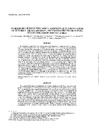Please use this identifier to cite or link to this item:
http://hdl.handle.net/10553/1211
| Title: | Análisis del riesgo volcánico asociado al flujo de lavas en Tenerife (Islas Canarias): escenarios previsibles para una futura erupción en la isla | Other Titles: | Analysis of the volcanic hazard associated with lava flows on Tenerife (Canary Islands): Predictable scenarios of a future eruption on the island | Authors: | Carracedo, J.C. Guillou, Hervé Paterne, Martine Scaillet, Stéphane Rodriguez-Badiola, Eduardo Paris, Raphaël Perez-Torrado, Francisco-Jose Hansen Machín,Alex Roberto |
UNESCO Clasification: | 250621 Vulcanología | Keywords: | Vulcanismo Teide (Tenerife) Canarias Previsión Riesgo eruptivo, et al |
Issue Date: | 2004 | Journal: | Estudios Geologicos | Abstract: | The spatial and temporal distribution of volcanic eruptions in the Canarian Archipelago are a consequence of their origin and evolution, in response to hotspot activity. Therefore, the probability that eruptive phenomena will occur is greater in the western islands (Tenerife, La Palma and El Hierro), the closest to the hotspot vertex, where hundreds of eruptions have been localized in the last 20.000 years. By contrast, in La Gomera (presently in the volcanic repose stage) and in the easterly islands of Gran Canaria, Fuerteventura and Lanzarote (the most distant and oldest, in the post-erosive stage of development), few eruptions, if any, have taken place during this period. Rift structures known as «dorsals» have been defined in the more active westerly islands, where the greater part of the recent volcanic activity has been concentrated. Objective data therefore exist that permit the assessment and zonification of eruptive hazards in the archipelago. In this work the assessment of volcanic hazards in the island of Tenerife is presented, whichare concentrated in the volcanic system formed by the central edifice of Mt. Teide and the Northwest Rift. Numerous radiometric datings (14C and K/Ar) and the preparation of detailed digitalized and georeferenced geological mapping (GIS) have permitted an initial analysis and assessment of the volcanic hazards in this island, which presents the greatest risk of eruptions because of the number of recent eruptions and their complexity, in addition to demographic density. La distribución en el tiempo y el espacio de las erupciones volcánicas en el Archipiélago Canario es consecuencia de su origen y evolución, como respuesta a la actividad de un punto caliente. Por consiguiente, la probabilidad de ocurrencia de fenómenos erupti- vos es mayor en las islas occidentales (Tenerife, La Palma y El Hierro), las más próxi- mas a la vertical del punto caliente, donde se han localizado centenares de erupciones en los últimos 20.000 años. En cambio, en La Gomera (actualmente en la fase de reposo volcánico) y en las islas orientales de Gran Canaria, Fuerteventura y Lanzarote (las más alejadas y antiguas, en la fase post-erosiva de desarrollo), no se han producido erupcio- nes en este período o sólo han sido unas pocas. Dentro de las islas occidentales más acti- vas se han definido unas estructuras -los rifts o dorsales- donde se concentra la mayor parte de la actividad volcánica reciente. Existen, por consiguiente, datos objetivos que permiten la evaluación y zonificación del riesgo eruptivo en el Archipiélago. En este trabajo se presenta la evaluación de la peligrosidad volcánica de la isla de Tenerife, concen- trada en el sistema volcánico formado por el edificio central del Teide y la dorsal Noroeste. Abundantes dataciones radiométricas (l4c y K/Ar) y la elaboración de una cartografía geológica de detalle digitalizada y geo-referenciada (SIG) han permitido la realización de un primer análisis y evaluación de los peligros volcánicos de esta isla, la de mayor riesgo eruptivo por el número de erupciones recientes y su complejidad, y por su densidad demográfica. |
URI: | http://hdl.handle.net/10553/1211 | ISSN: | 0367-0449 | Source: | Estudios Geologicos [ISSN 0367-0449], v. 60, p. 63-93 |
| Appears in Collections: | Artículos |
SCOPUSTM
Citations
10
checked on Mar 30, 2025
Page view(s)
159
checked on Oct 12, 2024
Download(s)
1,210
checked on Oct 12, 2024
Google ScholarTM
Check
Share
Export metadata
Items in accedaCRIS are protected by copyright, with all rights reserved, unless otherwise indicated.
